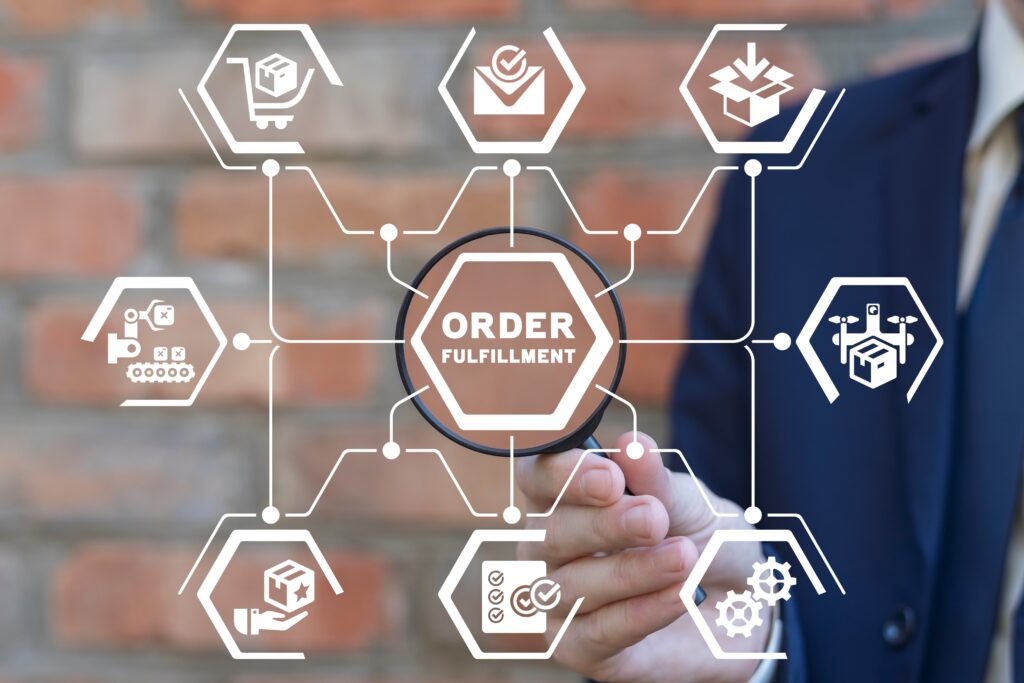The Complete Guide to E-Commerce Fulfillment
E-commerce fulfillment is a comprehensive process that encompasses the entire journey of a product from the moment an order is placed online to its delivery at the customer’s doorstep. It involves various intricate methodologies and approaches that make up the backbone of any successful online retail operation. Ultimately, this service ensures that customers receive their orders accurately and promptly.
Key Takeaways
- E-commerce fulfillment involves the comprehensive process of receiving, processing, and delivering online orders.
- It’s vital for any successful online retail operation and significantly influences customer satisfaction and business growth.
- Various fulfillment models are available, each with unique advantages and disadvantages. Choosing the best model depends on your business needs and goals.
- Managing fulfillment costs involves understanding the typical expenses like storage, picking and packing, and shipping.
- Working with a fulfillment provider can often prove cost-effective, as economies of scale and customized pricing can be achieved based on your needs.
- Preparing for future trends in e-commerce fulfillment is crucial for staying competitive and driving growth.
Increased Demand for E-Commerce Fulfillment
In recent years, the e-commerce industry has experienced exponential growth, fueled by the rise of online shopping and evolving consumer behaviors. According to Statista, global e-commerce sales are projected to reach $6.38 trillion in 2024, underscoring the massive expansion and importance of this sector. This surge has placed E-commerce fulfillment at the forefront of logistical innovation, transforming it into a critical component for businesses aiming to thrive in the digital marketplace.
Why is E-Commerce Fulfillment Important?
Beyond the sheer demand for E-commerce fulfillment, this process has become a major revenue driver for companies of all sizes. Efficient fulfillment operations means:
- Businesses are enabled to scale
- Enterprises can meet increasing customer demands
- Brands can maintain a competitive advantage
When executed well, E-commerce fulfillment can reduce operational costs, enhance customer satisfaction, and significantly boost profitability.
Throughout this guide, we’ll explore all the key components of E-commerce fulfillment, from integration to final mile delivery. Let’s take a closer look at the impact of this service on a company’s bottom line and reputation, and explore why SFI should be your go-to E-commerce fulfillment provider.

Understanding E-Commerce Fulfillment
E-commerce fulfillment refers to the comprehensive series of operations involved in receiving, processing, and delivering online orders to customers. This is an essential component of the E-commerce ecosystem, which ensures that products move seamlessly from the seller to the buyer. As a result, it encompasses various logistical tasks. Each is crucial for maintaining efficient operations and satisfying customer demands.
It is important to note that the scope of E-commerce fulfillment extends beyond mere order delivery; it includes inventory management, packaging, shipping, and handling returns. Each of these elements must run smoothly, as they can make or break the success of any online retail business.
Key Components of the Fulfillment Process
The E-commerce fulfillment process comprises several key components, each playing a critical role in ensuring that orders are fulfilled accurately and efficiently. These components include:
1. Receiving
Receiving involves the initial intake of products from suppliers or manufacturers into a fulfillment center or warehouse. This step is crucial as it sets the foundation for accurate inventory management. During receiving, items are counted, inspected for quality, and entered into the warehouse management system (WMS). Proper receiving practices ensure that the inventory data is accurate, which is vital for subsequent stages of the fulfillment process.
2. Storage
Once products are received and inspected, they can then be organized and stored in designated locations within the fulfillment center or warehouse. Effective storage strategies are essential for optimizing space and ensuring quick retrieval of items when orders are placed. This is especially essential when dealing with an E-commerce fulfillment provider, as they may have many client products stored within their facilities. Therefore, products are often categorized and stored based on factors such as demand frequency, size, and type.
Utilizing methods like bin shelving, pallet racking, and automated storage systems can enhance storage efficiency and accessibility. Keep in mind that specific organizational systems will depend on your E-commerce fulfillment provider.
3. Order Processing
Order processing is central to the fulfillment process, encompassing several steps to ensure that customer orders are accurately prepared for shipping.
- Order Picking: Items are retrieved from their storage locations. Efficient picking methods can significantly reduce picking time and increase accuracy. These might include batch picking, zone picking, or wave picking.
- Batch picking involves grouping multiple orders together and picking the items for all these orders simultaneously. Instead of picking items for one order at a time, the picker collects items for several orders in one trip.
- In zone picking, the warehouse is divided into different zones, and each picker is responsible for picking items only within their designated zone. Orders are passed from one zone to another until all items are collected.
- Wave picking involves organizing the picking process into waves or groups based on factors like order priority, shipping schedules, or product type. Pickers handle all orders within a wave in a coordinated manner.
- Order Packing: Picked items are carefully packed to protect them during transit. This involves choosing the right packaging materials, ensuring items are secure, and including necessary documentation like invoices and return labels.
- Quality Control: Final checks are conducted to ensure that the correct items are packed in the right quantities and in good condition before sealing the package.
4. Shipping
Shipping is the final stage of the fulfillment process, where the packed orders are dispatched to the customers. This involves selecting the appropriate shipping carrier, printing shipping labels, and coordinating pickup or delivery schedules. E-commerce fulfillment providers are known for having efficient shipping strategies that reduce delivery times and costs, enhancing end-customer satisfaction, but also the process between the brand and the provider.
Additionally, it’s worth enquiring whether your E-commerce provider will offer tracking information once items are shipped. This is a basic and yet crucial way to keep customers informed about the status of their orders, further improving the customer experience.
The Fulfillment Process: Driving Customer Loyalty
A seamless fulfillment process is essential for maintaining customer loyalty and fostering repeat business.
- The process begins with accurate inventory management, ensuring that stock levels are well-monitored and replenished as needed.
- Once an order is placed, the system must efficiently process it, followed by precise picking and packing to guarantee the right products are sent out in perfect condition.
- Shipping logistics are then coordinated to ensure timely delivery, and finally, a reliable returns process is put in place to handle any post-purchase issues smoothly.
Each stage of this process plays a pivotal role in the customer experience. For instance, fast and accurate order processing minimizes wait times, while meticulous packing protects products during transit. Reliable shipping ensures that customers receive their orders when expected, fostering trust and satisfaction. A hassle-free returns process demonstrates a commitment to customer care, encouraging loyalty and positive reviews.
E-commerce fulfillment is not merely a backend operation but a strategic asset that can significantly influence customer loyalty and business growth. By investing in robust fulfillment processes, companies can enhance their operational efficiency, meet customer expectations, and secure a loyal customer base, ultimately driving sustained revenue growth in the competitive E-commerce landscape.
Looking for Fulfillment Assistance?
E-Commerce Fulfillment Models
In the dynamic world of E-commerce, choosing the right fulfillment model is crucial for optimizing operations and meeting customer expectations. Here are several E-commerce fulfillment models available through multiple providers, each with its own set of advantages and disadvantages for sellers:
1. Self-Fulfillment
In self-fulfillment, the seller manages the entire fulfillment process in-house. This includes storing inventory, picking and packing orders, and shipping products directly to customers.
- Example Seller: A small business or artisan shop that wants to maintain control over every aspect of its customer experience.
| Pros | Cons |
| Full control over inventory, packaging, and shipping processes. | Can become overwhelming as order volumes increase. |
| Ability to personalize packaging and include branded materials. | Requires significant time, space, and workforce. |
| Direct handling of customer service issues, allowing for a more personal touch. | Potentially higher shipping costs without bulk discounts. |
2. Dropshipping
In dropshipping, the seller does not keep products in stock. Instead, when an order is placed, the seller forwards it to a third-party supplier, who then ships the product directly to the customer. This model eliminates the need for managing stock or handling shipping logistics, reducing overhead costs and simplifying operations. However, it also means the seller has less control over the product quality and delivery times.
- Example Seller: A new E-commerce entrepreneur looking to minimize upfront investment and inventory risk.
| Pros | Cons |
| No need to purchase inventory upfront or maintain storage space. | Limited control over inventory quality and shipping times. |
| Ability to offer a wide range of products without significant investment. | Lower profit margins due to supplier costs and potential dropshipping fees. |
| Reduced logistical burden as suppliers handle fulfillment. | Potential challenges in resolving customer service issues promptly. |
3. Amazon FBA
Sellers send their products to Amazon’s fulfillment centers. Amazon handles storage, picking, packing, shipping, and customer service for these products.
- Example Seller: An established E-commerce business looking to leverage Amazon’s extensive fulfillment network and reach.
| Pros | Cons |
| Products are eligible for Amazon Prime, increasing visibility and sales. | FBA fees can be substantial, impacting profit margins. |
| Scalability is simplified as Amazon handles logistics. | Limited control over branding and packaging. |
| Benefit from Amazon’s reliable customer service and return policies. | Potential direct competition with Amazon’s own products and other sellers. |
4. Third-Party Logistics (3PL)
A Third-Party Logistics (3PL) provider plays a critical role in the supply chain by offering comprehensive logistics services that enable E-commerce businesses to outsource their fulfillment operations. This model enables sellers to focus on their core business activities, such as product development, marketing, and sales, while the 3PL provider manages the complex logistics processes.
- Example Seller: A growing E-commerce brand looking to outsource logistics to focus on core business activities.
| Pros | Cons |
| Access to professional logistics expertise and advanced technology. | Service fees can be significant, depending on the level of service required. |
| Easily scalable to accommodate business growth. | Less direct control over the fulfillment process. |
| Bulk shipping rates and negotiated carrier discounts can lead to lower shipping costs. | Dependence on the 3PL’s performance and reliability. |
| Ensuring that orders are accurate and products are in good condition before shipping. | |
| Customizable services tailored to specific business needs. |
Choosing the Right E-Commerce Fulfillment Provider
Selecting the right E-commerce fulfillment provider is crucial for your business’s efficiency, customer satisfaction, and overall success. Beyond the model you think might work best, there are other details to consider to ensure providers can meet your expectations and needs. Here are key factors to review as you make your decision:
- Customer Service: Exceptional customer service is essential for maintaining a positive reputation and ensuring customer satisfaction. When evaluating providers, consider their responsiveness, availability of multiple support channels such as phone, email, and live chat, and customer feedback from other businesses.
- Scalability and Flexibility: Your fulfillment needs will evolve as your business grows, and your provider must be able to scale accordingly. Ensure the provider can handle increased order volumes during peak seasons and offer customized solutions to adapt to changing business needs.
- Seamless Integration and Automation: Efficient integration with your E-commerce platform and automation of processes streamline operations and reduce errors. Look for compatibility and integration potential with your E-commerce platform (e.g., Shopify, WooCommerce, Amazon) and features like automated order processing, inventory updates, and real-time tracking.
- Returns Management: A smooth returns process boosts customer satisfaction and loyalty. Evaluate the ease and efficiency of the provider’s returns process, and ensure they communicate clearly with customers about return policies and procedures.
- Cost Considerations: Cost is a significant factor when choosing a fulfillment provider. Assess the provider’s pricing structure, including storage fees, order processing fees, shipping costs, and any additional charges. Compare these costs with the value of the services provided to determine the best fit for your budget and operational needs.
- Data Tracking and Analytics: Data tracking and analytics capabilities are vital for monitoring your business performance and making informed decisions. Look for providers that offer comprehensive reporting tools, real-time data access, and insights into key metrics such as order accuracy, delivery times, and inventory levels.
SFI’s 3PL Services
When you partner with SFI for your E-commerce fulfillment needs, you gain access to a comprehensive range of services tailored to support your business’s growth and efficiency. Here’s how SFI can help:
Warehousing and Inventory Management
- Secure Storage: SFI’s strategically located warehouses near the Canada-U.S. border ensure your products are stored safely. The facilities are equipped with climate control to protect sensitive items.
- Advanced Tracking: Using RFID tags and barcode scanning, SFI provides real-time inventory visibility, enhancing accuracy and efficiency in stock management.
Order Processing and Shipping
- Efficient Fulfillment: SFI excels in picking, packing, and shipping orders efficiently. Their robust processes and multiple carrier options ensure the timely delivery of your products.
- Cost-Effective Shipping: When working with SFI as your E-commerce fulfillment provider, you’ll benefit from our partnerships with leading couriers and negotiated volume shipping rates, ensuring affordable and reliable shipping solutions.
Technology Integration
- Seamless E-commerce Integration: SFI’s systems integrate smoothly with major E-commerce platforms like Amazon, Shopify, and ERP systems like SAP and Sage, automating key processes your business already has in place.
- Automated Processes: From order placement to shipping, SFI’s platform ensures a streamlined workflow, reducing manual intervention and improving turnaround times.
Returns Management
At SFI, we simplify the returns process with clear customer communication and efficient handling of returns and exchanges, improving customer satisfaction and operational efficiency.
Section 321 Fulfillment
Section 321 is a U.S. Customs program that allows goods valued at $800 or less to be imported duty-free into the U.S. This simplifies the import process by reducing taxes and paperwork for smaller shipments. Remarkably, even products from China can enter the U.S. duty-free when shipped through Canada.
When you choose SFI as your E-commerce fulfillment provider, you can fully benefit from Section 321. Our Canadian warehouses are strategically located to help speed up customs clearance and minimize administrative work. Our team of shipping experts ensures that your shipments meet all Section 321 rules, making the process even smoother for your business.
Why Choose SFI?
Compared to other providers, SFI stands out for its personalized service and deep expertise in both customs brokerage and logistics. Our customer-centric approach ensures that each client receives a strategy tailored to their specific needs rather than a one-size-fits-all solution. With over 70 years of experience and a track record of millions of successful cross-border shipments, our team is proud to offer unmatched reliability and efficiency in E-commerce fulfillment.

Have a Question about SFI?
Costs Associated with E-Commerce Fulfillment
Understanding the costs associated with E-commerce fulfillment is essential for managing your business’s budget and ensuring profitability. Here is a breakdown of the typical fulfillment costs:
Storage
Storage costs are incurred for keeping your inventory in the fulfillment center’s warehouse. These costs can vary based on the amount of space your products occupy, the duration they remain in storage, and any special requirements such as climate control. Providers typically offer flexible pricing options based on your specific storage needs.
Picking and Packing
Picking and packing costs cover the labor and materials involved in retrieving items from storage, packaging them securely, and preparing them for shipment. These costs can depend on factors such as the complexity of the order, the type of packaging materials used, and the level of customization required. Efficient picking and packing processes can help optimize these costs, ensuring that orders are processed accurately and quickly.
Shipping
Shipping costs are associated with transporting the packaged orders to your customers. These costs can vary widely depending on the destination, shipping speed, package size, and weight. Fulfillment providers often work with multiple carriers to offer a range of shipping options, allowing you to choose the most cost-effective solution for your business. Additionally, shipping costs can be influenced by the provider’s negotiated rates with carriers and any special shipping requirements you might have.
Customizable Pricing
It’s important to note that pricing for E-commerce fulfillment services is often customized based on your specific needs and the provider you choose. Many fulfillment providers offer tailored pricing structures that consider the unique aspects of your business, such as order volume, product type, and any special handling requirements. By working closely with your fulfillment provider, you can develop a cost-effective strategy that meets your operational needs and budget constraints.
How to Optimize Your Fulfillment Strategy
Optimizing your E-commerce fulfillment strategy is crucial for reducing costs, improving efficiency, and ensuring customer satisfaction. Here are some key tips and considerations for achieving these goals:
Automate Where Possible
Utilize automated systems for order processing, inventory management, and shipping. Automation can significantly reduce manual errors and labor costs while speeding up the fulfillment process. Business owners can incorporate these systems by identifying repetitive tasks in their operations and selecting software solutions tailored to their specific needs, ensuring seamless integration and improved efficiency.
Streamline Inventory Management
Implement efficient inventory management practices, such as just-in-time inventory, regular audits, and accurate demand forecasting. This helps avoid overstocking or stockouts, reduce storage costs, and ensure products are available when needed.
Implementation Tips
Start by investing in robust inventory management software that offers real-time tracking and analytics. This technology allows for more accurate and strategic stock control, aiding in the optimization of your overall fulfillment process.
Optimize Packaging
Use cost-effective, size-appropriate packaging for your products. Opt for lightweight materials to reduce shipping costs and consider eco-friendly options to appeal to environmentally conscious customers.
Implementation Tips
Business owners should audit their current packaging processes, explore sustainable materials, and partner with suppliers who provide customizable and eco-friendly packaging solutions.
Negotiate with Carriers
Build relationships with multiple shipping carriers and negotiate rates to find the most cost-effective shipping solutions.
Implementation Tips
Consider using shipping software that compares carrier rates and services to choose the best option for each order. Business owners can also benefit from regularly reviewing and renegotiating contracts with carriers, leveraging volume discounts, and staying informed about market rates and trends to secure the best deals.
Leverage Data Analytics
Use data analytics to monitor and analyze your fulfillment operations. Track key performance indicators (KPIs) such as order accuracy, delivery times, and return rates to identify areas for improvement and make informed decisions.
Implementation Tips
Business owners can take actionable steps by setting up dashboards that visualize these KPIs, conducting regular performance reviews, and using insights from the data to optimize processes and enhance customer satisfaction.
Distributed Inventory
Storing inventory in multiple locations closer to your customer base can significantly reduce shipping times and costs, providing a faster delivery experience for customers. Additionally, distributing inventory across different regions helps mitigate risks from disruptions such as adverse weather, strikes, or other unforeseen events, ensuring a more resilient supply chain. By achieving faster delivery times and maintaining reliable shipping, businesses can improve customer satisfaction and loyalty, ultimately leading to a more robust and dependable operation.
Implementation Tips
Analyze sales data to determine where your customers are predominantly located and strategically place inventory in those regions. Further, you can partner with third-party logistics providers that offer distributed warehousing solutions to leverage their existing infrastructure.
Advanced Software Solutions
Advanced software provides real-time visibility into inventory levels, order status, and shipping progress, enabling better management and quicker response to issues. Additionally, seamless integration with your E-commerce platform, CRM, and other business systems ensures smooth operations and reduces manual data entry errors. Access to detailed analytics and reporting further enhances decision-making, allowing you to make data-driven choices to optimize your fulfillment strategy.
Need Help Optimizing Your Fulfillment Strategy?

Implementation Tips
Assess and select fulfillment software that aligns with your business needs, ensuring it offers features such as inventory management, order processing, and shipping integration. From here, ensure your team is well-trained in using the software to maximize its benefits and streamline your fulfillment operations.
Myths and Misconceptions About E-Commerce Fulfillment
When it comes to E-commerce fulfillment, several myths and misconceptions can lead businesses to make less informed decisions regarding how this aspect of their enterprise is handled. Below, we address some of the more common myths to provide clear insights to help business owners understand the true value and potential of optimized fulfillment strategies.
My Business Isn’t Big Enough to Outsource Fulfillment
- Myth: Small businesses often believe they are not large enough to benefit from outsourcing their fulfillment operations.
- Fact: Outsourcing fulfillment is beneficial for businesses of all sizes. Small businesses, in particular, can gain significant advantages from leveraging the expertise and resources of a fulfillment provider. By outsourcing, even small E-commerce businesses can offer faster shipping times, better customer service, and handle larger order volumes during peak periods. This allows them to compete with larger companies and focus more on growth and customer engagement rather than logistics.
Outsourcing Order Fulfillment is Too Expensive
- Myth: Many business owners assume that outsourcing their order fulfillment will be prohibitively expensive and eat into their profit margins.
- Fact: While there are costs associated with outsourcing, these expenses often pale in comparison to the benefits and potential savings. Fulfillment providers can offer economies of scale, such as bulk shipping discounts and reduced overhead costs. Additionally, outsourcing can free up resources that can be redirected toward marketing, product development, and other growth-focused activities. When factoring in the cost of labor, storage, packaging materials, and the opportunity cost of managing fulfillment internally, outsourcing often proves to be a cost-effective solution.
I Will Have Less Control If I Use a 3PL
- Myth: There is a common concern that using a Third-Party Logistics (3PL) provider means losing control over the fulfillment process and customer experience.
- Fact: Modern 3PL providers offer robust transparency and control through advanced technology and communication tools. Businesses can access real-time data and analytics to monitor their inventory, orders, and shipments. Many 3PLs also support customized packaging and branding to maintain a consistent customer experience. Rather than losing control, partnering with a 3PL can enhance your control by providing detailed insights and more precise management tools.

Fulfillment Companies Won’t Handle My Inventory Carefully
- Myth: Some business owners worry that a third-party fulfillment company will not handle their products with the same care and attention as they would themselves.
- Fact: Reputable fulfillment providers prioritize the careful handling and accurate processing of inventory. They implement strict quality control measures, use advanced technology to track inventory and train their staff extensively to ensure that all products are handled properly. Additionally, fulfillment centers often have state-of-the-art facilities designed to store and manage inventory securely and efficiently. Partnering with a reliable fulfillment provider ensures that your products are in good hands.
Fulfillment Isn’t Worth the Hassle
- Myth: The perceived complexity and effort required to set up outsourced fulfillment can deter businesses from exploring this option.
- Fact: While transitioning to an outsourced fulfillment model requires some initial setup and adjustments, the long-term benefits far outweigh the initial effort. Fulfillment providers often have streamlined onboarding processes and dedicated support teams to assist businesses in the transition. Once set up, outsourcing fulfillment significantly reduces the day-to-day operational burden, allowing businesses to scale more efficiently and improve overall customer satisfaction. The enhanced efficiency, scalability, and professional handling provided by fulfillment partners make the initial setup well worth the investment.
Maximizing Your Fulfillment with SFI
At SFI, we tackle concerns head-on and offer a transparent yet comprehensive perspective on our 3PL services. As you consider whether or not to use a logistics provider to handle your E-commerce fulfillment, know that we have worked with seemingly countless brands and companies, each with their own unique needs. Our longevity in the industry, coupled with our current expertise, positions us as a natural fit to maximize your fulfillment opportunities.
Technology Integration
SFI leverages RFID and barcode scanning technologies to accurately track inventory and reduce errors in order picking and shipping, ensuring real-time visibility of inventory. We also have IoT sensors to monitor environmental conditions within the warehouse, within our warehouses, crucial for maintaining proper storage conditions, especially for temperature-sensitive items.
Network of Fulfillment Centers
SFI operates multiple strategically located fulfillment centers near the Canada-U.S. border, enabling efficient cross-border logistics and quick delivery times. Each of our fulfillment centers in Brockville and Prescott, Ontario, and Ogdensburg, New York, provide over 150,000 square feet of warehouse space. These locations are optimally positioned to facilitate two-day delivery to more than 60% of the population in both Canada and the U.S.
Additional Services
SFI offers a variety of additional services to meet the diverse needs of businesses:
- Kitting: Combining multiple products into a single package, which is particularly useful for subscription boxes or promotional bundles. This service helps businesses streamline their packaging processes and offer customized product combinations.
- B2B Orders: SFI adeptly handles large-scale B2B orders, ensuring timely and accurate fulfillment for business clients. Their expertise in handling bulk shipments ensures efficiency and reliability for B2B operations.
- International Shipping: With extensive experience in cross-border logistics, SFI provides seamless international shipping services. Our platform automates customs documentation and ensures compliance with international regulations, simplifying the shipping process for businesses.
Getting Started with SFI
Engaging with SFI for your E-commerce fulfillment needs is a straightforward process designed to ensure seamless integration and efficient service delivery. Here’s a step-by-step guide:
Step 1: Reach Out to SFI
Use our contact form to reach out, or call our customer service line to express your interest in fulfillment services. If possible, provide details about your business, including the nature of your products, volume of orders, and specific logistics needs to help us better understand your requirements.
Step 2: Schedule a Consultation
SFI will schedule a consultation to discuss your logistics consultant professionals. This can be conducted over the phone, via video call, or in person. We recommend you prepare questions about our services and pricing and invite you to inquire about how we can tailor our solutions to meet your business needs.
Step 3: Needs Assessment
During the consultation, we’ll assess your fulfillment needs, including storage, inventory management, order processing, and shipping requirements. It would be helpful if you share your current logistics challenges and goals to help us understand how we can best support your business.
Step 4: Receive a Customized Proposal
Based on the needs assessment, our team will provide a detailed proposal outlining the services we recommend, associated costs, and implementation timeline. Please review the proposal carefully and ask for clarification on any points that are unclear. Further, ensure the proposed services align with your business objectives.
Step 5: Sign the Service Agreement
Once you’re satisfied with the proposal, sign the service agreement to formalize the partnership!
Step 6: Onboarding Process
SFI will initiate the onboarding process, which includes integrating your E-commerce platform with our systems and setting up your account in our customer portal.
Step 7: Implementation Phase
SFI will set up your inventory in our fulfillment centers, configure system integrations, and conduct tests to ensure all processes run smoothly.
Step 8: Training and Support
SFI will train your team to use its systems, manage orders, and handle returns as needed.
Step 9: Go-Live
After successful implementation and testing, your fulfillment operations with SFI will go live. Orders will start being processed and shipped from SFI’s fulfillment centers.

Fulfillment Challenges and Solutions
E-commerce fulfillment presents various challenges that businesses must navigate to maintain efficiency and customer satisfaction. Understanding these challenges and implementing effective solutions is crucial for success. Here are some common fulfillment challenges and strategies to overcome them:
Customer Expectations and Branding Opportunities
- Challenge: Modern E-commerce customers have high expectations for fast, reliable, and personalized service. Meeting these expectations while maintaining brand consistency can be difficult.
- Solution: To meet customer expectations, invest in a fulfillment provider that offers advanced technology for real-time order tracking, inventory management, and efficient packing and shipping processes. Personalize the customer experience by including branded packaging and customized inserts in shipments. Clear communication about order status and delivery times can enhance customer satisfaction. Utilizing technology to gather and analyze customer feedback helps in continuously improving the fulfillment process.
Returns Management
- Challenge: Efficiently handling returns is a major challenge, as it involves reverse logistics, restocking, and potential loss of inventory value.
- Solution: Develop a clear, customer-friendly returns policy and communicate it effectively on your website. Use technology to streamline the returns process, making it easy for customers to initiate returns online and track the status of their returns. Implement automated systems for processing returns quickly and accurately. Additionally, analyze return data to identify common issues and take corrective actions to reduce return rates in the future.
High Shipping Rates
- Challenge: High shipping costs can diminish profit margins and deter potential customers from completing purchases.
- Solution: Negotiate shipping rates with multiple carriers to secure the best possible deals. Consider offering free shipping for orders above a certain value to incentivize larger purchases. Use shipping software to compare rates and delivery times across different carriers and choose the most cost-effective options. Implement packaging strategies that minimize the size and weight of shipments to reduce shipping costs.
Complex Management Software
- Challenge: Managing fulfillment operations using complex software can be daunting, especially for businesses without dedicated IT resources.
- Solution: Choose user-friendly fulfillment software that integrates seamlessly with your existing E-commerce platform and other business systems. Ensure the software offers comprehensive support and training resources to help your team get up to speed quickly. Consider using cloud-based solutions that offer scalability and regular updates without the need for extensive in-house IT management. Simplified dashboards and intuitive interfaces can make it easier to monitor and manage fulfillment processes effectively.
Future Trends in E-Commerce Fulfillment
The E-commerce landscape is constantly evolving, and staying ahead of emerging trends is crucial for businesses to maintain a competitive edge. By understanding and preparing for these trends, companies can enhance their fulfillment strategies and improve overall operational efficiency. Here are some key future trends in E-commerce fulfillment and how businesses can capitalize on them:
Diversify Suppliers
- Trend Insight: The global supply chain disruptions experienced in recent years have highlighted the risks of relying on a single supplier or region.
- Preparation Strategy: To mitigate these risks, businesses should diversify their supplier base. Establishing relationships with multiple suppliers across various regions can ensure a steady supply of products, even amidst geopolitical issues, natural disasters, or other disruptions. Additionally, exploring local sourcing options can reduce lead times and enhance supply chain resilience. By diversifying suppliers, companies can enhance their flexibility and responsiveness to market changes.

Real-Time Monitoring
- Trend Insight: Real-time visibility into supply chain and fulfillment operations is becoming increasingly important for ensuring efficiency and customer satisfaction.
- Preparation Strategy: Implement advanced tracking and monitoring systems that provide real-time updates on inventory levels, order status, and shipping progress. Use IoT (Internet of Things) devices and sensors to gather data on warehouse operations and product movement. This data can be integrated with AI-driven analytics platforms to predict potential issues and optimize workflows. Real-time monitoring allows businesses to proactively address problems, improve decision-making, and enhance customer communication.
Sustainability Initiatives
- Trend Insight: Consumers are prioritizing sustainability more than ever, placing pressure on businesses to adopt eco-friendly practices.
- Preparation Strategy: Integrate sustainability into your fulfillment strategy by using eco-friendly packaging materials, optimizing shipping routes to reduce carbon emissions, and implementing energy-efficient practices in warehouses. Partner with carriers and suppliers that prioritize sustainability and have transparent environmental policies. Additionally, consider offering carbon-neutral shipping options or participating in carbon offset programs. Emphasizing sustainability not only meets consumer demand but also positions the business as a responsible and forward-thinking brand.
Personalization
- Trend Insight: Personalization is becoming a key differentiator in the E-commerce space, with consumers expecting tailored experiences.
- Preparation Strategy: Leverage data analytics to gain insights into customer preferences and behaviors. Use this information to personalize the fulfillment experience, from customized packaging and branded inserts to personalized communication and product recommendations. Advanced CRM (Customer Relationship Management) systems can help businesses manage and analyze customer data to deliver more personalized experiences. Personalization enhances customer loyalty and satisfaction, driving repeat business and long-term growth.
Automation
- Trend Insight: Automation is revolutionizing E-commerce fulfillment, enabling faster, more accurate, and cost-effective operations.
- Preparation Strategy: Invest in automation technologies such as robotics, automated storage and retrieval systems (AS/RS), and AI-powered order processing. Automation allows businesses to streamline tasks like picking, packing, and sorting, reducing labor costs and minimizing errors. Implementing automation also allows businesses to scale operations quickly and efficiently to meet growing demand. Additionally, explore the use of automated customer service solutions, such as chatbots and virtual assistants, to handle routine inquiries and support tasks.
Embracing Change and Future Opportunities
The E-commerce fulfillment landscape is poised for significant advancements, and businesses that embrace these trends will be well-positioned for future success. By diversifying suppliers, implementing real-time monitoring, prioritizing sustainability, enhancing personalization, and adopting automation, companies can create a robust and adaptable fulfillment strategy.
However, it is essential to remain open to interpretation and adaptable to potential changes in the market. Continuous monitoring of industry developments, consumer preferences, and technological innovations is crucial for staying ahead. Engaging in industry forums, attending trade shows, and collaborating with thought leaders can provide valuable insights and keep businesses informed about emerging trends and best practices.
In Summary
In the ever-evolving world of E-commerce, optimizing your fulfillment strategy is crucial for maintaining efficiency, reducing costs, and enhancing customer satisfaction.
As you reflect on these insights and consider your own fulfillment strategy, it’s essential to choose a partner who can provide tailored solutions and support your business’s unique needs. At SFI, we offer comprehensive E-Commerce fulfillment services designed to enhance your operational efficiency and customer satisfaction.
Contact our team today for a personalized quote and discover how our expertise and advanced solutions can help you optimize your fulfillment strategy and achieve long-term success.
Looking for Help With E-commerce Fulfillment?
Frequently Asked Questions
Seasonal demand significantly impacts E-commerce fulfillment by creating spikes in order volumes during peak periods such as holidays, back-to-school seasons, and special sales events. These fluctuations can strain fulfillment operations, leading to potential delays, stockouts, and increased errors if not properly managed.
- To prepare for seasonal demand, start by analyzing historical sales data to predict upcoming trends and ensure adequate inventory levels.
- Work closely with your 3PL provider to align on forecasted volumes and inventory needs, ensuring they can support the increased demand.
- Collaborate closely with suppliers to confirm their ability to meet higher order volumes.
- Additionally, consider hiring temporary staff or cross-training existing employees to efficiently manage the surge in orders.
- Implementing automated systems can also streamline order processing, picking, and packing, reducing the risk of errors and speeding up fulfillment times.
- Regular communication and coordination with your 3PL provider will help ensure a smooth and effective response to seasonal demand increases.
Communication with customers is crucial—keep them informed about potential delays or changes in shipping times due to high demand. Offering expedited shipping options and clear return policies can enhance customer satisfaction during busy periods. By proactively planning and leveraging technology, you can effectively manage seasonal demand, ensuring a smooth and efficient fulfillment process that meets customer expectations.
Yes, E-commerce fulfillment can be optimized for sustainability by implementing eco-friendly practices across various stages of the fulfillment process. This includes using sustainable packaging materials, optimizing shipping methods, and reducing waste.
Start by selecting biodegradable or recyclable packaging materials and minimizing packaging size to reduce waste and shipping costs. Implementing a paperless system for invoices and receipts can further decrease environmental impact. Additionally, consider consolidating shipments when possible to reduce the number of deliveries and associated emissions.
Where possible, optimize your supply chain by choosing carriers that offer carbon-neutral shipping options or participate in carbon offset programs. Employing route optimization software, or if your 3PL provider does, can also help reduce fuel consumption by selecting the most efficient delivery routes.
By focusing on these areas, businesses can not only reduce their environmental impact but also appeal to eco-conscious consumers, potentially increasing customer loyalty and brand reputation.
Handling fulfillment for oversized or heavy items requires specialized strategies to ensure efficiency and cost-effectiveness. These items often present unique challenges, including higher shipping costs, the need for special packaging, and additional handling requirements.
- Invest in Appropriate Packaging Materials: Work with your 3PL provider to source sturdy, custom-sized boxes, reinforced packaging, and adequate cushioning materials to protect items during transit. Ensure they have access to these materials and understand your specific packaging requirements.
- Check Your Fulfillment Center: Ensure that your 3PL provider’s fulfillment center is equipped with the necessary tools, such as forklifts and pallet jacks, to handle large items safely and efficiently.
- Negotiate Shipping Costs: Your 3PL provider should negotiate rates with multiple carriers. Leverage their existing relationships and expertise to secure the best rates, especially with carriers that specialize in handling oversized items. Your 3PL provider can also help by offering bulk shipping or freight services to mitigate costs.
- Implement Technology Solutions: Ensure your 3PL provider uses barcode or other tracking systems that can accurately track the location and movement of oversized inventory. This technology will help streamline order processing and shipping, reducing the risk of errors.
- Clear Communication with Customers: Work with your 3PL provider to ensure clear communication with customers regarding shipping times and any additional fees for large items. This helps manage expectations and ensures customer satisfaction.
Technology plays a pivotal role in modern E-commerce fulfillment by enhancing efficiency, accuracy, and customer satisfaction. Advanced technologies streamline various aspects of the fulfillment process, from inventory management to order processing and shipping.
- RFID systems are integral to managing inventory levels, tracking product locations, and optimizing storage space. These systems provide real-time data, ensuring that inventory is accurately monitored and replenished as needed.
- Automated picking and packing systems, such as robotics and conveyor belts, minimize human error and reduce labor costs, increasing order accuracy.
- Order Management Systems (OMS) integrate with E-commerce platforms to automate order processing, ensuring that orders are quickly and accurately fulfilled. These systems also provide real-time updates to customers about their order status, enhancing transparency and customer satisfaction.
Managing inventory across multiple fulfillment locations requires a strategic approach to ensure efficiency and accuracy. One of the best practices is to use an integrated inventory management system that provides real-time visibility into stock levels at all locations. This helps prevent stockouts and overstocking, ensuring that inventory is balanced and available where it is needed most.
Another critical practice is to implement a robust demand forecasting model. By analyzing historical sales data and considering seasonal trends, you can predict demand more accurately and distribute inventory accordingly. Additionally, adopting an automated replenishment system can ensure that inventory levels are maintained at optimal levels without manual intervention.
Regular audits and cycle counts at each fulfillment location are essential to maintaining inventory accuracy. These checks help identify discrepancies early and reduce the risk of inventory shrinkage.
Furthermore, ensuring your 3PL provider, if you use one, has clear communication and coordination protocol between different fulfillment centers is crucial. This includes having standardized procedures for inventory transfers, order fulfillment, and reporting. At SFI, these practices are standardized, ensuring nothing slips through the cracks.
Ensuring the security of your products during the fulfillment process is paramount to maintaining customer trust and preventing losses.
- One of the first steps is to implement a robust inventory tracking system that provides real-time visibility into product movement within the fulfillment center. This helps monitor stock levels and quickly identify discrepancies or potential security breaches.
- Physical security measures are also critical. Ensure that your fulfillment center is equipped with surveillance cameras, access control systems, and adequate lighting.
- Restricted access areas for high-value items and secure storage facilities can further protect your inventory. Conduct regular security audits to identify and address any vulnerabilities in your fulfillment process.
- Additionally, adopting technology solutions such as RFID tags and barcode systems can enhance inventory tracking and security. These technologies help monitor product movement accurately and deter theft.
- Lastly, consider partnering with a reputable third-party logistics provider that prioritizes security and has proven protocols in place to protect your products throughout the fulfillment process.
Reducing shipping times to international customers involves several strategic approaches. The most effective strategy is to partner with a reliable 3PL that offers expedited shipping options and has extensive networks in your target markets. These carriers often provide faster and more reliable delivery services compared to standard shipping methods.
Keep in mind that customs clearance can often be a bottleneck in international shipping. Ensure your 3PL has a team of experienced customs brokers who are well-versed in international regulations and can expedite the clearance process, minimizing delays.
Effectively managing customer expectations regarding shipping and delivery is crucial for maintaining satisfaction and trust. Having clear and accurate information about shipping times and delivery options on your website can be one way to ensure customer expectations are managed. Working with your 3PL provider, you might consider offering detailed shipping policies, including estimated delivery times and any potential delays as well to manage all relevant details related to shipping.
Offering multiple shipping options, including standard, expedited, and same-day delivery, allows customers to choose the service that best meets their needs. These options may depend on your 3PL provider.
Additionally, consider implementing a robust internal customer service system that can handle inquiries and resolve issues efficiently. Having a responsive and helpful customer support team available via multiple channels (e.g., phone, email, live chat) can address any concerns customers may have regarding their shipments.
Lastly, you can also use these channels to collect and analyze customer feedback to continuously improve your shipping and delivery processes. Understanding common pain points and addressing them proactively is essential to building a loyal customer base.
Common pitfalls in E-commerce fulfillment can hinder efficiency and customer satisfaction, but they can be avoided with careful planning and execution.
- Inaccurate inventory management can lead to stockouts or overstocking. To avoid this, implement a robust inventory management system that provides real-time visibility and accurate tracking of stock levels.
- Slow order processing can delay shipments and frustrate customers. Streamlining your order processing workflow with automation tools can speed up the process and reduce errors. Ensure that your 3PL is well-versed in advancements to reduce order processing errors.
- Poor packaging can result in damaged goods and increased returns. Invest in high-quality packaging materials and ensure that products are packed securely to withstand transit. Regularly review and update your packaging processes to prevent damage and minimize returns.
- Shipping delays are another frequent challenge. Partner with a reliable 3PL that has connections with carriers and uses multiple shipping options to mitigate delays. Providing accurate tracking information and communicating proactively with customers about potential delays can help manage expectations.
- Neglecting customer service can significantly damage your reputation. Ensure that you have a responsive customer support team in place to handle inquiries and resolve issues promptly. Collecting and analyzing customer feedback can help identify areas for improvement and enhance your overall fulfillment strategy.
The integration of E-commerce platforms with fulfillment services involves connecting your online store to a third-party logistics provider’s system to streamline order processing, inventory management, and shipping. This integration typically occurs through APIs (Application Programming Interfaces) that enable seamless data exchange between the two systems.
When an order is placed on your E-commerce platform, the details are automatically transmitted to the fulfillment provider. This includes information such as the customer’s address, order items, and shipping preferences. The fulfillment provider then processes the order, picks and packs the items, and prepares them for shipment. Real-time updates about order status and tracking information are sent back to the E-commerce platform, allowing customers to monitor their orders.
Integrating your E-commerce platform with a fulfillment service offers several benefits, including improved efficiency, reduced manual errors, and enhanced customer experience.
To successfully integrate your E-commerce platform with a fulfillment service, choose a provider that offers seamless compatibility with your existing system. Ensure that the provider’s technology supports your business needs and can handle your order volume.
Yes, you can switch fulfillment providers if you’re not satisfied with your current service, but the process requires careful planning to ensure a smooth transition. It’s best to identify the reasons for your dissatisfaction and clearly define your requirements for a new fulfillment provider. This will help you select a provider that better aligns with your business needs.
- Begin the switch by conducting thorough research and vetting potential fulfillment partners. Look for providers that offer the services and capabilities you need, and consider their reputation, technology, and customer support. Once you’ve chosen a new provider, negotiate terms and finalize the contract.
- Next, plan the transition phase to minimize disruptions to your operations. This involves coordinating with both your current and new fulfillment providers to manage inventory transfer, system integration, and order fulfillment. Create a detailed timeline for moving inventory from the old warehouse to the new one, ensuring that order processing is uninterrupted.
- Communicate the change to your customers, especially if there will be any temporary impacts on order fulfillment. Keep them informed about the transition and provide updates on the expected improvements.
- Finally, monitor the new provider’s performance closely during the initial period to ensure they meet your expectations. Address any issues promptly and maintain open communication to build a strong partnership.
Tracking the right metrics is crucial for measuring the success of your fulfillment strategy and identifying areas for improvement. Here are some key metrics to monitor:
- Order Accuracy Rate: This metric measures the percentage of orders fulfilled correctly without errors. High order accuracy is essential for customer satisfaction and reducing returns.
- Order Processing Time: Track the time taken from receiving an order to shipping it. Shorter processing times indicate efficient operations and faster delivery to customers.
- Inventory Turnover Rate: This measures how often your inventory is sold and replaced over a specific period. A high turnover rate indicates effective inventory management and demand forecasting.
- Return Rate: Monitor the percentage of orders returned by customers. Analyzing return reasons can help identify issues with product quality, fulfillment errors, or customer expectations.
- Shipping Time: Measure the average time taken for orders to reach customers after shipping. Faster shipping times enhance customer satisfaction and loyalty.
- Fulfillment Cost per Order: Calculate the total cost of fulfillment (including storage, picking, packing, and shipping) divided by the number of orders you receive.



